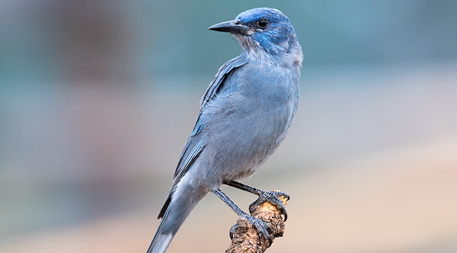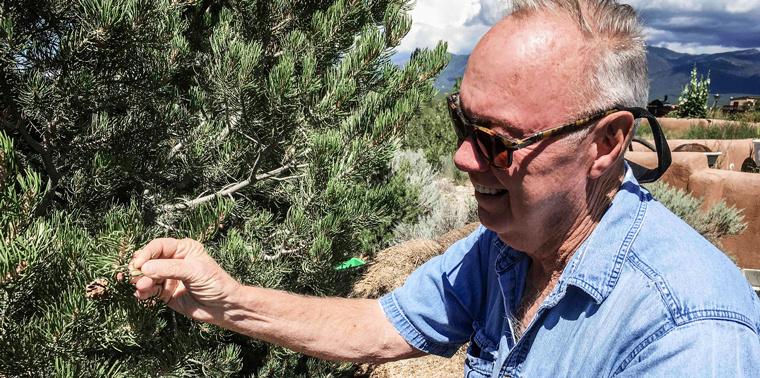September 26, 2017 — Among the rolling mesas north of Taos, New Mexico, a lush piñon pine tree reaches skyward from a rocky slope. John Ubelaker bends to its base and counts the number of branches swirling from the ground to the crown. “Young one,” he says of the tree. “It’s about 20 or so years old. Lucky one, too. It survived the dieback.”
The retired Southern Methodist University biologist hands me a palm-sized cone sticky with sap. His blue eyes are bright and excited. “It takes three years for the piñon to form cones with nuts inside,” he explains. “But the cycle is moisture dependent. It won’t happen without enough water.”
Over the past 10 years, northern New Mexico has seen a decrease in spring moisture, according to Ubelaker. That means less pollen and less fertilization, he says. “We could see a big hit coming to these trees. And that would be a shame. They’re important.”

Forested areas dominated by pinyon and/or juniper stretch across the American Southwest. Image courtesy of NPS
The piñon pine thrives in the arid climate of the Southwest U.S., producing a copious amount of delicately flavored seeds prized by wildlife and humans alike. It isn’t a fast-growing tree, often taking decades to reach just 6 feet (2 meters) in height. But it’s a tough tree, bursting from dry, steep and rocky soils inhospitable to many other species. And piñons can be extremely long-lived, taking 75 to 200 years to reach maturity and at times living to be 1,000 years old.
Three major species of piñon are native to the region and, along with junipers, cover nearly 100 million acres (40 million hectares) reaching from Texas to California. Numerous plant and animal species, including turkeys, black bears, squirrels and chipmunks, depend on the environmental conditions created by the tree, and piñon-juniper woodlands help to moderate watershed functions by slowing rainfall and snowmelt, allowing it to soak into the soil. Native Americans collected piñon nuts for eons before Europeans arrived. For them it remains an important tree used for food, fuel, medicines and building materials.
For more recent arrivals to the the Southwest the tree is just as important — so much so that New Mexico made the piñon the state tree in 1949. Across its range, the piñon is a multi-million dollar part of the economy. Scientists consider the piñon to be one of the most important trees in the American West. So many wildlife and plant species depend on the piñon that its loss would have drastic impacts.
In other words, “the piñon is a keystone species in the Southwest,” Ubelaker says.

The piñon jay is among many species of animals that depend on piñon pines for food and shelter. Image © iStockphoto.com/drferry
As climate changes, however, heat, drought, wildfire and insects threaten this tree, in turn threatening the wildlife, people and ecosystems that depend on it. Forestry experts in the Southwest paint an uncertain future for the plucky piñon and the ecosystems and economies it supports. But it doesn’t look positive.
Forecast: Heat Up, Dry Out
A prolonged drought that began in the 1990s brought home the threat climate change poses to the piñon. By the early 2000s some 350 million piñons were dead, with some areas in New Mexico reporting nearly 100 percent mortality.
“It was the biggest piñon kill in 500 years,” says Paulette Ford, a research ecologist with the U.S. Forest Service Rocky Mountain Research Station in Fort Collins, Colorado.
Since 2010, a number of wet years have reduced the threat of drought across the Southwest. Still, many researchers and natural resource professionals look at the 1998–2010 drought and wonder: Is this a sign of things to come?
“The strong monsoons we’ve enjoyed the past few summers have allowed the piñon forest to recover from the drought, but we are very uncertain as to how the monsoons will change in the future,” says Park Williams, assistant research professor at the Lamont-Doherty Earth Observatory of Columbia University.
Average temperature in the U.S. Southwest is expected to climb 5 to 7 °F (3 to 4 °C) by 2100, while average annual precipitation is expected to decrease. Indeed, as the planet warms, the U.S. Southwest is expected both heat up and dry out. According to a 2016 U.S. Department of the Interior Bureau of Reclamation SECURE Water Act report to Congress, average temperature in the U.S. Southwest is expected to climb 5 to 7 °F (3 to 4 °C) by 2100, while average annual precipitation is expected to decrease. Perhaps most concerning, says New Mexico state climatologist David DuBois, is the anticipated shift in precipitation.
“We expect more rain in the winter months and less snow,” he says. The result will be less snowpack in the mountains, an earlier and shorter runoff season, and drier mountain forests in the summer months. “Some climate projections for parts of north-central New Mexico show up to a 9 °F [5 °C] increase in max temperatures for winter months by 2100. That’s big.”
Thus far, says DuBois, it is hard to see a strong signal in the data as to how precipitation is changing. Temperature changes are a little clearer. “Morning lows, for just one example, are much warmer already. And that trickles down to impact plants.”
Piñon Implications
Even for the hardy piñon the shift in temperature matters. According to Williams, a tree will notice even a 1 °F (0.5 °C) increase in temperature.
“For the most common trees of the Southwest — the ponderosa pine, Douglas fir and piñon — temperature is as important as precipitation, if not more so,” he says. In a 2009 study, Henry Adams, a Ph.D. student at the University of Arizona in Tucson, exposed New Mexico piñons to temperatures about 4 °C (8 °F) higher than they were used to. The piñons were dead in 18 weeks.
With more drought in the forecast, large-scale beetle outbreaks are expected to rise.There also appears to be a connection between how hot it is and the likelihood that a piñon will be killed by the ips bark beetle. Native to the Southwest, the ips is not generally considered terribly harmful. In fact, it helps in forest decomposition and serves as food for birds such as woodpeckers. It also burrows under the bark of pine or spruce and digs tunnels through the tree that can kill.
Typically, the ips only attacks trees that are weak or under some form of stress. But when widespread conditions such as drought occur, the beetle’s population builds to such a level that it can cause massive destruction. With more drought in the forecast, large-scale beetle outbreaks are expected to rise: When water is scarce, piñons have a hard time making sap, which is their main weapon against the beetle.
Big Shift Underway
Still, there is dispute as to exactly what is happening with the Southwest’s piñons. The tree greatly expanded its range through the 1980s and 1990s and perhaps outgrew its range, according to John Shaw, a biological scientist with the U.S. Forest Service Rocky Mountain Research Station. “The dieback may have been somewhat of a correction, but it is hard to say. When epidemic insect populations are involved it also tends to be [an overcorrection].” But for now, he says, it appears that the population has stabilized.

As climate changes, the iconic Southwest U.S. landscape is changing also, with unknown consequences for forest ecosystems. Image © iStockphoto.com/grandriver
Overall, however, a big shift does seem to be underway. Between 1984 and 2008 nearly 20 percent of southwestern forests were lost to wildfire and bark beetle, according to a study Columbia University’s Williams authored. A study published in Nature Climate Change in 2015 predicted that by 2050 widespread tree death would take place, and by 2100 the piñon could be virtually wiped out in the Southwest.
Williams suspects that prediction is too extreme because it did not take topography into account. “There will undoubtedly be some places where conditions remain wet and cool enough to support piñon trees in 2100,” he says. But it does seem as though the forests of the region are lurching into a type of new ecosystem humans have not seen in easily 1,000 years.
“We don’t want these glorious piñons to become dinosaurs. But they could turn into just that.” – John UbelakerResearchers remain unsure how climate-driven forest die-off will impact ecosystems. Will a die-off simply start the successional clock over, or will it shift the entire trajectory of an ecosystem? The loss or near loss of an entire ecosystem as large as the piñon is hard to fathom. Even if not all piñons disappear, a reduction to small, higher altitude pockets of piñons will still have profound impacts on the region. While a new system will naturally supplant the piñon, will it be a system that can support the wide range or wildlife, human activity and ecosystem services the piñon provides?
Forestry experts and managers appear helpless in the face of such a change. In certain areas, human intervention can no doubt prolong the longevity of the piñon, but the massive range of the tree makes it both financially and practically impossible to conserve as the Southwest heats up and dries out. Climate change will bring changes, and humans and wildlife will be forced to adapt. Says Ubelaker: “We don’t want these glorious piñons to become dinosaurs. But they could turn into just that.”
Only Time Will Tell
Back out on the tablelands north of Taos, Ubelaker points to a piñon jay and describes how the jay plucks seeds from the cones of piñon trees and stores them in great piles on the south side of the trees. Snowfall buries the seeds, hiding them in the winter, a stash only the jay, with its incredible memory, knows about. The bird feeds from these stores through the winter months. But many of the seeds sink into the soil or fall from the bird’s mouth, and the tree spreads quickly.
“It’s an incredible interaction between the bird and the tree,” says Ubelkar. “They depend on each other. They sustain each other.”
Rising above, towering thunderheads mark the Southwest monsoon season. Before long, cold fat drops are falling from the sky. New Mexico hasn’t recently seen the drought and massive forest fires that became commonplace between 1995 and 2015. But odds are they will return. As for what that means for this essential tree and the life that depends on it, only time will tell. ![]()
Ensia shares solutions-focused stories free of charge through our online magazine and partner media. That means audiences around the world have ready access to stories that can — and do — help them shape a better future. If you value our work, please show your support today.
Yes, I'll support Ensia!

None the less, most scenarios I've seen show NM being one of the most hard hit areas if we don't cut our carbon emissions drastically. I loved NM, but it's future doesn't look so good unless we pass national legislation to cut GHG's. Citizens' Climate Lobby's carbon fee and dividend legislation will reduce CO2 emissions by 50% (or more) in 20 years.